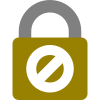คอมมอนส์:นโยบายการป้องกันหน้า
Shortcuts: COM:P • COM:PROTECT • COM:PPOLICY

ผู้ดูแลระบบสามารถเปิดใช้การป้องกันหน้าหรือไฟล์เพื่อป้องกันการแก้ไขหรือย้ายหน้า บางการป้องกันจะหมดเวลาในไม่นาน
This ability is usually only used to combat vandalism and edit wars and the protection is usually temporary. Some exceptions include heavily used templates and archived user right request pages.
The protection log shows a record of which pages have been protected, by whom, and the reason they gave for protection. All the pages that are currently protected are listed on Special:Protectedpages. Nonexistent pages that are protected against creation are listed on Special:Protectedtitles.
Fully protected pages should be tagged with the appropriate protection template to inform others and to auto-categorize the page under Category:Protected. Semi-protected pages are generally not tagged.
Types of protection
Full protection

Full protection disables editing for everyone except administrators. Fully protected media files cannot be overwritten by new uploads except by administrators. Pages may be full protected indefinitely if they are heavily used images or frequently transcluded templates to prevent vandalism. Indefinite full protection may also be used for pages which should not be modified for copyright or legal reasons, such as Commons:GNU Free Documentation License.
Pages experiencing edit warring as the result of a dispute may be temporarily protected. During this time, administrators should only make significant changes if there is consensus to do so. Any proposed changes should be discussed on the talk page. Such requests may, if they are immediate and uncontroversial, be accompanied by the {{Editprotected}} tag to attract administrators' attention.
การป้องกันเทมเพลต

Template protection is used on higher risk templates and Lua modules, such as those with a high transclusion count or those with licensing information. Pages under this protection can only be edited by administrators and those with the template editor user right.
Semi-protection

Semi-protection disables editing for anonymous users and registered accounts less than four days old. This is the most common type of protection and is commonly used to prevent IP vandalism.
Move protection

Move protection protects the page solely from being moved. By default, fully protected pages are also move protected.
Cascading protection

Cascading protection fully protects all pages transcluded on the protected page, including any images and their file description page, and any templates. Due to the widespread and powerful nature of cascading protection, its usage should be kept to a minimum. On Commons, cascading protection should only be used in rare situations where there's a consensus to do so.
In the past, it wasn't possible to protect nonexistent pages from being created. As a workaround, these pages were transcluded on a page that had cascading protection. It is now possible to protect pages using MediaWiki's built-in protection of nonexistent pages, which is applied in the same manner as ordinary protection. However, the old method has not been abandoned completely.
Cascading semiprotection is disabled, because it enabled non-sysops to fully protect pages by transcluding them.
Upload protection

Upload protection might be used to prevent overwriting of files that are either heavily used across Wikimedia projects (e.g. template icons) or used in a dangerous location (e.g. wiki's main pages) in order to prevent vandalism. These protections might be indefinitely or temporary, for example only as long as a file is on a wiki's main page. For “heavily used” files [upload=sysop] and (to prevent malicious or accidental moves) [move=sysop] should be used. [edit=sysop] is not needed (and not useful since it, for example, does not allow category changes) if just the file's contents are important (e.g. if only very few views of the file page can be expected as it happens in non-linked template use).
Requesting protection and unprotection
- To request protection
- Ask an administrator or make a request on Commons:Administrators' noticeboard/Blocks and protections.
- To request unprotection
- First, ask the administrator who protected the page.
- If they are unresponsive, ask a different administrator or ask at Commons:Administrators' noticeboard/Blocks and protections.
